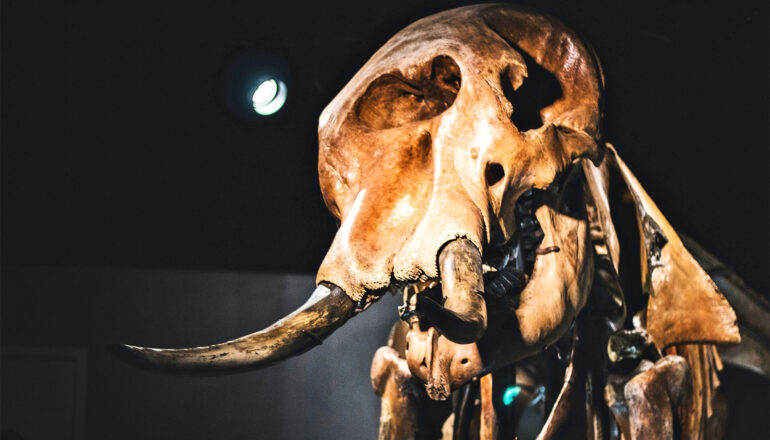
Researchers have discovered fossils of ancient chromosomes preserved in the remains of a woolly mammoth that died 52,000 years ago.
The chromosomes were structurally preserved down to the nanometer scale. The three-dimensional arrangement of the DNA fragments in the fossil was shown to be frozen in place for tens of millennia, preserving the entire chromosome structure.
“Fossil chromosomes are a game-changer,” says Olga Dudchenko, an assistant professor of molecular and human genetics at Baylor College of Medicine and a senior investigator at the Center for Theoretical Biological Physics (CTBP) at Rice University. “Knowing the shape of an organism’s chromosomes allows us to assemble the entire DNA sequence of extinct creatures, enabling insights that were previously impossible.”
The woolly mammoth’s remains, preserved in Siberian permafrost, offer a new tool for studying the history of life on Earth. Unlike typical ancient DNA fragments, which are rarely longer than 100 base pairs, the mammoth’s fossil chromosomes can span hundreds of millions of genetic letters.
By examining the mammoth’s fossil remains, the team determined it had 28 pairs of chromosomes.
“It is the same number as the mammoth’s closest living relatives, modern elephants,” says José Onuchic, professor of physics and astronomy, chemistry, and biosciences at Rice and CTBP co-director. “However, obtaining the structures for the mammoth required integrating the experimental data and physical modeling.”
Additionally, the preserved chromosomes allowed scientists to see which genes were active via a phenomenon known as chromosome compartmentalization. Many genes whose activation state was altered compared to modern elephants were associated with hair follicle development—unlike modern elephants, woolly mammoths had a thick coat of hair. The ancient chromosomes also retained structural features similar to modern chromosomes, including chromatin loops as small as 50 nanometers.
The researchers faced a puzzle: How could ancient chromosomes remain intact for 52,000 years? To explain this, they proposed that the chromosomes were in a state resembling glass, where individual DNA fragments couldn’t move far, preserving their structure.
“This glasslike state of the mammoth remains, induced by cooling and dehydration, is like that of the jerky we often eat as a snack in Texas,” says Peter Wolynes, professor of science and professor of chemistry, biosciences, materials science and nanoengineering, and physics and astronomy at Rice.
Co-corresponding author of the study Erez Lieberman Aiden, professor of molecular and human genetics at BCM and a senior investigator at CTBP, adds, “Basically, the chromosomes were trapped inside a piece of freeze-dried woolly mammoth jerky for 50,000 years.”
The researchers confirmed the resilience of this freeze-dried jerky, showing that while it shattered like glass, the chromosomes remained intact inside it.
Using an advanced GPU computing cluster donated by AMD, the research team could go one step further, reconstructing the three-dimensional ensemble of structures of woolly mammoth chromosomes.
“Recently, experiments along with theory have made it possible to study the detailed structures of modern chromosomes,” says Vinicius Contessoto, a research scientist at CTBP. “But this is the first time that we have been able to turn back the clock, as it were, and look at chromosomes of extinct species in full 3D.”
Although no elephant data were used to recreate the 3D chromosome structures for mammoths, the results are remarkably similar to those of modern elephant chromosomes, Contessoto says.
This research not only opens new avenues for studying ancient life but also provides insight into the genetic makeup of long-extinct species.
“It’s an exciting new frontier for biology and physics,” says Cynthia Pérez Estrada, a researcher at the Center for Genome Architecture at BCM and at CTBP.
The study appears in the journal Cell.
Additional coauthors are from Rice, CTBP, the University of Copenhagen, and Centro Nacional de Análisis Genómico and the Centre for Genomic Regulation in Barcelona, Spain.
Source: Rice University
The post Chromosome fossils found in ‘freeze-dried woolly mammoth jerky’ appeared first on Futurity.
from Futurity https://ift.tt/h1HpIub
No comments:
Post a Comment